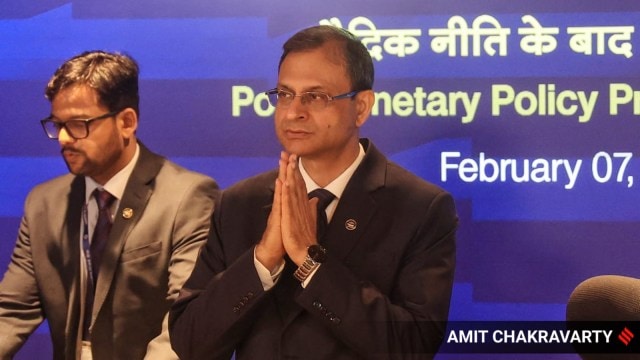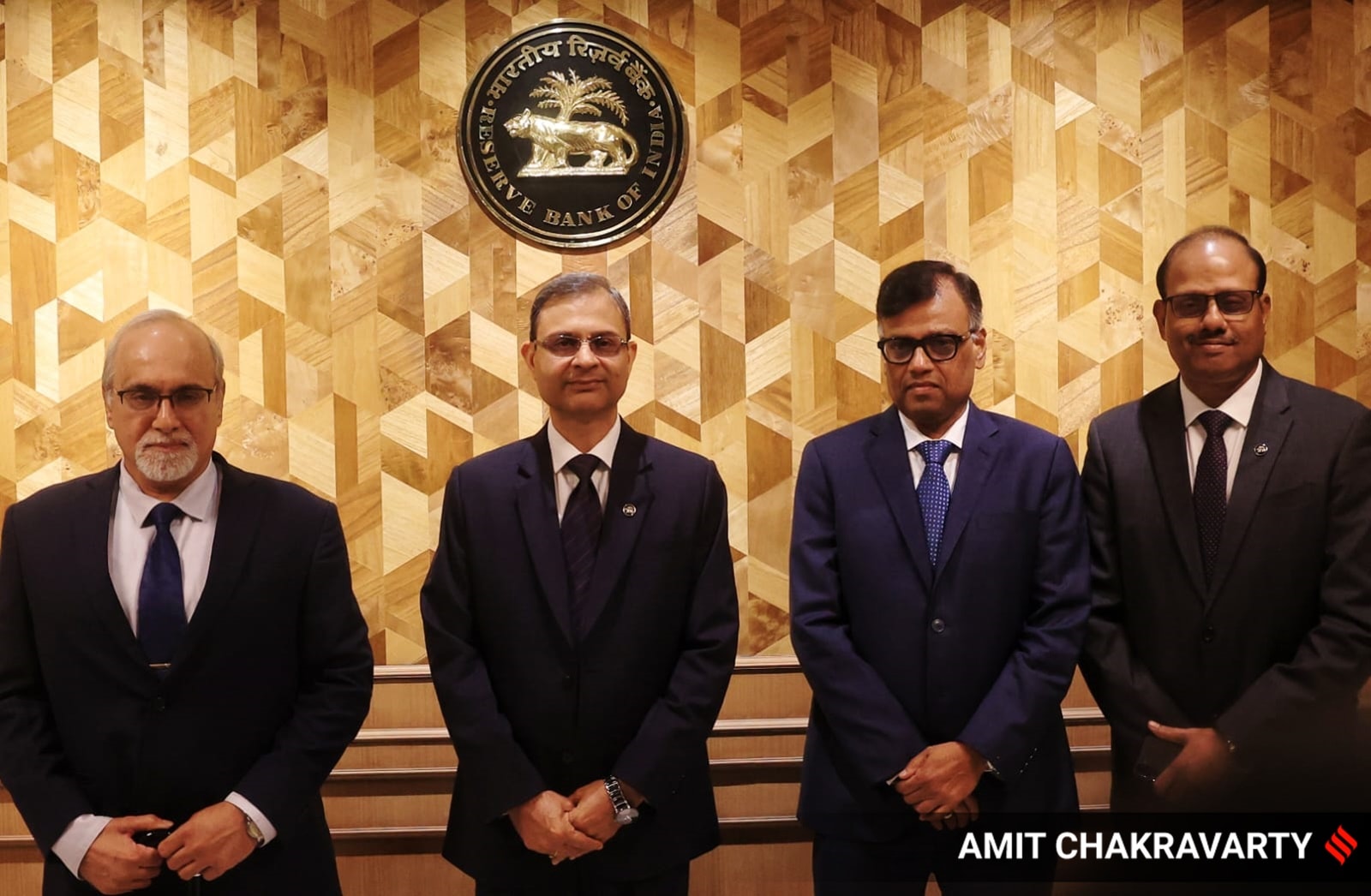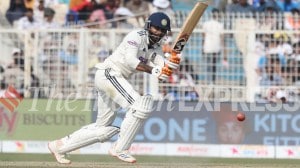RBI MPC Meeting 2025: RBI cuts repo rate by 25 basis points to 6.25%, a first in 5 years; estimates FY26 GDP growth at 6.7%
RBI Monetary Policy Meeting Announcements: The repo rate, till now, stood at 6.5 per cent. The move comes barely a week after the Centre cut personal income tax to boost consumption.
 RBI Governor Sanjay Malhotra after the announcement of the Monetary Policy. (Express Photo: Amit Chakravarty)
RBI Governor Sanjay Malhotra after the announcement of the Monetary Policy. (Express Photo: Amit Chakravarty) RBI MPC Meeting February 2025: The Reserve Bank of India’s (RBI) six-member Monetary Policy Committee (MPC) Friday cut the repo rate — the rate at which the RBI lends to other banks — by 25 basis points to 6.25 per cent. This is the first rate cut initiated by the RBI in five years, the last one being in May 2020.
The repo rate, till now, stood at 6.5 per cent. The move comes barely a week after the Centre cut personal income tax to boost consumption.
The RBI’s MPC, in a unanimous decision, lowered the repo rate in a bid to stimulate economic activity by making borrowing cheaper, thereby encouraging spending and investment. The MPC, however, decided to continue with its “neutral” stance for the economy, which RBI Governor Sanjay Malhotra explained would provide flexibility to respond to the evolving macroeconomic environment.
Malhotra said that the framework has served the Indian economy very well over the years, including the very challenging period since the pandemic, and average inflation has been lower post the introduction of this framework. He added that since the introduction of the framework, CPI has been largely aligned to the target, barring a few occasions of breaching the upper tolerance band.
RBI and MPC will continue to improve the macro-economic outcomes in the best interest of the economy using the flexibility embedded in the inflation targeting framework, while responding to the evolving growth-inflation dynamics, the RBI Governor said, adding that the building blocks of the Framework will be refined further by making advances in the use of new data, improving forecasting of key macroeconomic variables, and develop more robust models.
The policy is being announced amid global uncertainty, with US President Donald Trump announcing tariffs on Canada, Mexico and China. The tariffs on Canada and Mexico have been postponed for a month. The tariffs have also triggered a fear of global trade wars, resulting in a rise in the dollar against major currencies on Monday.
 RBI Governor Sanjay Malhotra with members of the Monetary Policy Committee. (Express Photo: Amit Chakravarty)
RBI Governor Sanjay Malhotra with members of the Monetary Policy Committee. (Express Photo: Amit Chakravarty)
What about GDP forecast?
The central bank estimates GDP growth in next fiscal year at about 6.7 per cent, Governor Sanjay Malhotra announced. The central bank estimates GDP growth in next fiscal year at about 6.7 per cent, Governor Sanjay Malhotra announced.
The government, according to the Economic Survey that was released before the Budget, projected a growth rate of 6.3-6.8 per cent for 2025-26 on the back of a “strong external account, calibrated fiscal consolidation and stable private consumption”.
This came in the backdrop of a slowing economy, which is estimated to grow at 6.4 per cent in 2024-25, the slowest in four years.
What has been said about inflation?
The Reserve Bank has projected retail inflation at 4.2 per cent for next financial year beginning April while retaining the forecast for 2024-25 at 4.8 per cent.
“Assuming a normal monsoon next year, CPI inflation for 2025-26 is projected at 4.2 per cent with Q1 at 4.5 per cent; Q2 at 4 per cent; Q3 at 3.8 per cent; and Q4 at 4.2 per cent,” the Governor said, while adding that risks were evenly balanced.
CPI-based inflation declined to a four-month low of 5.22 per cent in December, mainly on account of easing of prices in the food basket, including vegetables. It was at 5.48 per cent in November.
“MPC noted that inflation has declined, supported by a favourable outlook on food and continued transmission of past monetary policy action. It is expected to further moderate in 2025-26, gradually aligning with the target. The MPC also noted that while growth is expected to recover from the low of Q2 of 2024-25, it is much below that of last year. This growth-inflation dynamic opens up policy space for the MPC to support growth, while remaining focussed on aligning inflation with the target,” Malhotra said.
What happens when repo rate is cut?
When the RBI reduces the repo rate, all external benchmark lending rates (EBLR) linked to the repo rate will come down, giving relief to borrowers as their equated monthly instalments (EMIs) will fall.
Lenders may also reduce interest rates on loans that are linked to the marginal cost of fund-based lending rate (MCLR), where the full transmission of a 250 bps hike in the repo rate between May 2022 and February 2023 has not happened.
Measures to counter cyber frauds
The RBI Governor also listed out measures the central bank is taking to counter cyber frauds. “Rapid digitalisation of financial services has brought convenience and efficiency, but has also increased exposure to cyber threats and digital risks that are progressively getting sophisticated, Malhotra said.
He also announced a couple of measures undertaken by the RBI to prevent such frauds — an additional factor of authentication being extended to online international digital payments made to offshore merchants, and the implementation of “bank.in” exclusive Internet domains for Indian banks and “fin.in” domain for the rest of the financial sector.
RBI’s intervention in the forex market
The RBI’s exchange rate policy over the years has remained consistent and its stated objective is to maintain orderliness and stability without compromising forex market efficiency, Sanjay Malhotra said.
He added: “The RBI’s intervention in the forex market is focussed on smoothening excessive and disruptive volatility, and it does not target any exchange rate level or band. The exchange rate of the Indian rupee is determined by market forces.”
What else has the RBI Governor said?
Sanjay Malhotra also reassured all stakeholders that the central bank will continue with the consultative process that it has been following over the years in formulating regulations. He added that stakeholders’ suggestions are valuable and will continue to be considered seriously before any major decision.
On implementation of such regulations, Malhotra said that the RBI will ensure that it is smooth and sufficient time is given for transition, and where regulations have major implications, the implementation will be done in a phased manner.
Speaking about the current economic situation, the RBI Governor said that the global economy is currently growing below the historic average, even though high frequency indicators suggest resilience along with continued expansion in trade. “Progress on global disinflation is stalling, hindered by services price inflation,” he added.
He further stated that with receding expectations on the size and pace of rate cuts in the US, the dollar has strengthened, bond yields have hardened, emerging market economies have experienced large capital outflows leading to sharp depreciation of their currencies and tightening of financial conditions. “Divergent trajectory of monetary policy across advanced economies lingering geopolitical tensions, and elevated trade and policy uncertainties have exacerbated financial market volatility. Such an uncertain global environment has posed uncertain policy trade-offs in emerging market economies,” he added.
The Governor further said that while the Indian economy continues to remain strong and resilient, it has not been immune to global headwinds with the rupee coming under depreciation pressure in the recent past. “RBI has been applying all tools at its disposal to face the multi-pronged challenges,” he added.
Speaking about the risks that the economy face, Malhotra said that the MPC felt that excessive volatility in global financial markets and continued uncertainties about global trade policies, coupled with adverse weather events pose risks to the growth and inflation outlook.





- 01


























